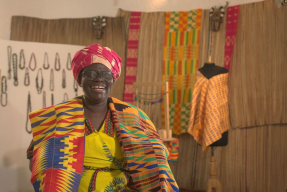By Suzy Marinkovich, KF9 Bolivia
We can’t get enough of them. We love them so much that they even have their own lending team of fans and a discussion on KivaFriends. Whether they are made of straw or soft fabric, bowler, flat-brimmed, or a tiny saucer looking thing on our borrower’s heads – we just love them.
There is an old English adage that says, “If you want to get ahead in life, you should get yourself a hat.”
I like hats, and I’ll wear one every now and again – maybe for Opening Day in Del Mar or during a long hike to beat the heat (and, of course, during San Diego Padres baseball games). But down here, it’s an essential part of your everyday cholita’s wardrobe – it’s her piece of flair, her fashion statement, and it’s also almost always a statement about where she comes from. Her hat may very well give away her hometown – and whether others see her as a Cochabambina or an Ayacuchana, for example.
When I saw our “Women in Hats” lending team, I was in love! I promise not to get all deep on you, but I thought it was such a cute, simple way that cultures across the world can come together through Kiva – by celebrating even the simplest of accessories. It also conveys why loaning on Kiva is so fun (and addictive) for us!
So, I decided to do a little light research into this hat phenomenon. Since I arrived in Bolivia from Peru, the hat styles have definitely changed. These ones are usually small bowler hats and I cannot for the life of me figure out how they seem to defy physics by not flying off their owner’s heads. Sometimes they are tilted off to the side, sometimes they add a solid 10 inches to a woman’s height – which I guess lends itself to the aforementioned English adage.
I began by Googling “bowler hats Bolivia” and soon found out that they’re called a “bombin” down here. When I Googled that however, all I got were a bunch of articles on bombings (since Google was certain I made a typo) and some Wu Tang Clan lyrics about “bombin’ buildings.” I take it that bombin hats aren’t a typical Google search. Regardless, I dug a little deeper and here’s a synopsis of what I found:
The bowler hat – or bombin – has been worn by Quechua and Aymara women in Peru and Bolivia since the 1920s, when it was introduced to Bolivia by British railway workers. Rumor has it that the hats were found to be too small for their intended recipients, so they were then distributed to the locals. For many years a factory in Italy manufactured the hats for the Bolivian market. Now, however, they are produced internationally. This seems to be the most popular theory of bombin origination. (Main source: Wikipedia.org)
Another rumored and uncorroborated bombin hat theory involves an over-order of bowler hats by an enterprising salesman, who supposedly convinced the Bolivian locals that the wearing of hats would increase their fertility. Whether that was once the belief or not, you may be relieved to know that this rumor certainly isn’t prevalent today.

To rewind and broaden our subject a little, it’s worth noting that in the aftermath of the 1781 pan-Andean rebellion against Spanish rule, colonial officials forbade the use of indigenous dress, hoping to suppress any identification with an autonomous Indian culture (Source: Lesley Gill, “Proper Women and City Pleasure: Gender, Class, and Contested Meanings in La Paz”). I learned in Cuzco that all of the styles we see today, from women in hats, skirts, and blouses to men’s pants, came originally from the Spanish. They saw the Andean people wearing what they considered to be odd attire: long, floor-length, and simple gowns. It was decided that the Andeans should dress more like the peasantry attire prevalent in feudal Europe. As a result, Andean people embraced the new styles while paying homage to their own cultures by using bright, woven colors and uniquely styled hats. Those are what we see today and classify as uniquely South American; which they are, but it’s interesting to know where it all began.
Although detailed historical information on changes in dress throughout the 19th century is not available, we do know that during the early 20th century, urban Aymara women wore the so-called Panama hats, which were actually produced in Ecuador. These hats were subsequently replaced by the contemporary derbies sometime after World War II. The most fashionable brand—Borsaline—was produced in Italy, and even after the firm closed its Italian factory, it opened one in La Paz exclusively for the Bolivian market. (Source: Caiiavesi de Sahonero 1987)
I tip my hat to the various sources from which I drew upon to write the paragraphs above. Please feel free to comment on this post with your own hat facts (and rumors)!
Lastly, if you find yourself drawn to lovely women in stylish hats, we can help you. Just click here.
Sonrisas y abrazos desde Bolivia (smiles and hugs from Bolivia)!
Suzy Marinkovich is a Kiva Fellow at new Kiva partner CIDRE in Cochabamba, Bolivia, the second of her three placements. She has a wholehearted passion for microfinance, social justice, and poverty alleviation. Suzy is most excited to listen to the incredible stories of Kiva borrowers in South America and let them know how much they continually inspire us all. Click here to support fundraising borrowers at CIDRE!
/>













